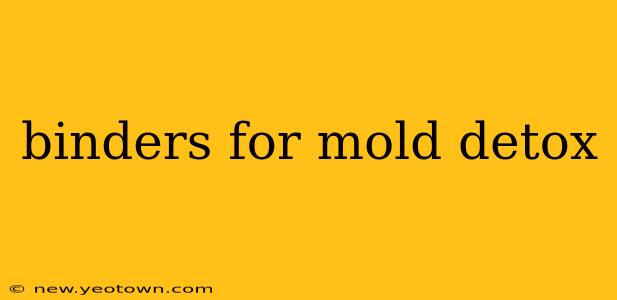Mold exposure can significantly impact health, leading to a range of symptoms often referred to as "mold toxicity" or mold illness. While the medical community is still researching the full extent of mold-related health issues, many individuals find relief through detoxification strategies. One key component of these strategies is the use of binders—substances that help the body remove toxins, including mycotoxins produced by mold. This guide explores the role of binders in mold detox, addressing common questions and concerns.
What are Binders, and How Do They Work in Mold Detox?
Imagine your body as a bustling city. Mycotoxins, the toxic byproducts of mold, are like unwanted pollutants. Binders act as specialized cleaning crews, sweeping up these pollutants and preventing them from causing further damage. They work by binding to mycotoxins in the digestive tract, preventing their absorption into the bloodstream. These bound toxins are then eliminated from the body through bowel movements.
What are the Best Binders for Mold Detox?
Several natural substances have shown promise as binders in supporting mold detoxification. It's crucial to remember that these are supportive measures and not a replacement for medical advice. Always consult a healthcare professional before starting any detoxification program.
Some commonly used binders include:
-
Activated Charcoal: Known for its high absorptive capacity, activated charcoal effectively binds to a wide range of toxins, including mycotoxins. However, it's important to use pharmaceutical-grade activated charcoal and follow dosage instructions carefully.
-
Chlorella: This single-celled green alga is a nutritional powerhouse packed with chlorophyll and other beneficial compounds. Chlorella acts as a binder, helping to eliminate toxins from the body. It also offers nutritional support, which can be beneficial during detoxification.
-
Zeolites: These volcanic minerals possess a unique porous structure, enabling them to bind to various toxins, including heavy metals and mycotoxins. Clinoptilolite is a specific type of zeolite often used for detoxification.
-
Bentonite Clay: This absorbent clay has been used for centuries for its detoxifying properties. It binds to toxins in the digestive tract, helping to remove them from the body. However, ensure you source high-quality, food-grade bentonite clay.
-
Psyllium Husk: This soluble fiber is a gentle binder that adds bulk to the stool, promoting regular bowel movements and helping to eliminate toxins.
Are There Any Side Effects to Using Binders for Mold Detox?
While generally considered safe when used correctly, binders can sometimes cause side effects. These can include constipation (especially with high doses or insufficient water intake), nausea, and stomach upset. Starting with a low dose and gradually increasing it, while staying well-hydrated, can help minimize these effects.
It's crucial to select high-quality products from reputable sources. Always follow the recommended dosage instructions on the product label.
How Long Should I Use Binders for Mold Detox?
The duration of binder use varies depending on individual needs and the severity of mold exposure. Some individuals may benefit from short-term use, while others may require longer-term supplementation. A healthcare professional can provide personalized guidance based on your specific situation.
What Other Detoxification Strategies Can I Use Along with Binders?
Binders are just one part of a comprehensive mold detoxification strategy. Other supportive measures include:
- Air purification: Removing mold from your environment is critical. Use HEPA filters and address any moisture problems.
- Dietary changes: Focus on nutrient-dense foods that support liver function.
- Supportive therapies: Consider therapies like sauna, infrared therapy, or lymphatic drainage massage to support detoxification.
- Medical supervision: It is crucial to have medical supervision and testing to guide your detoxification process.
What if I'm Allergic to Mold? Should I Still Use Binders?
If you have a mold allergy, you should always consult an allergist or immunologist before starting any detoxification protocol, including the use of binders. Mold allergy management often involves avoidance strategies, allergen immunotherapy, and medication to manage symptoms. Binders may play a supplementary role but should be used under medical supervision.
This information is for educational purposes only and should not be considered medical advice. Always consult with a healthcare professional before starting any detoxification program, especially if you have pre-existing health conditions or are taking medications. They can help determine the best approach for your individual needs and ensure your safety throughout the process.

